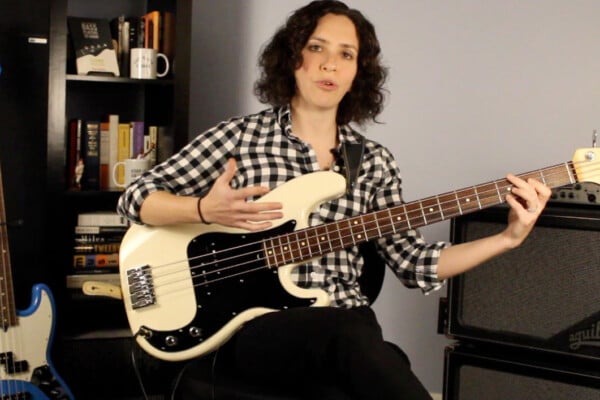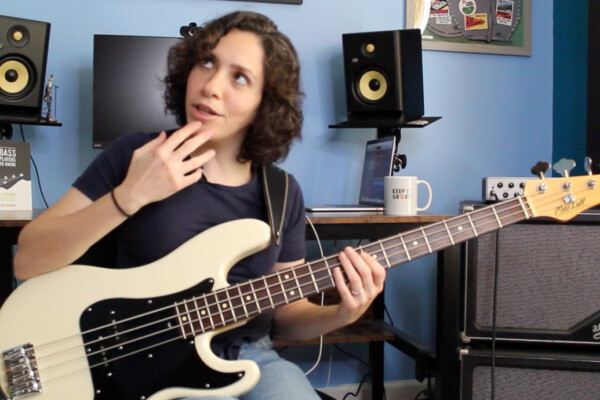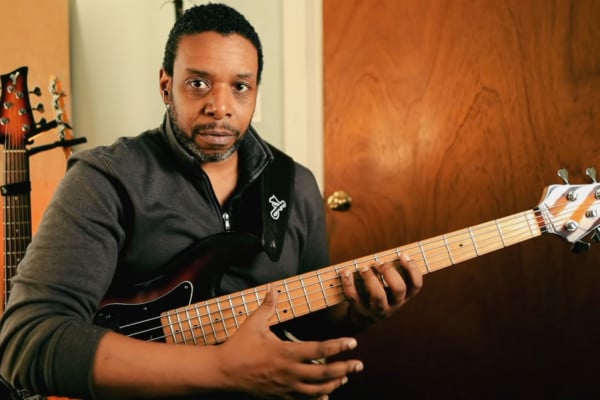Talking Technique: The Pistol Grip
If you’ve been following this column for a while, you know we place a lot of emphasis on the details of good technique, including the left hand. Sometimes, though, we go to see our favorite bass players and they have the “pistol grip”. So is it really necessary to use one finger per fret and good posture on the fretboard?
In this lesson, we’ll discuss the disadvantages and advantages of the pistol grip. Stay tuned for today’s tip to learn how to change your habits without losing your passion.
Austrian-gone-Californian Ariane Cap is a bassist, educator, blogger and author. In her book Music Theory for the Bass Player and corresponding 20-week online course, she teaches music theory, bass technique, bass line creation and fretboard fitness in a systematic, practical and experiential way. She just released a brand new course on ear training for the bass player: Ear Confidence - 6 Paths to Fearless Ears. Contact her via her blog or website.




I realised many years ago that the pistol grip was restrictive and quickly tried to get rid of it. but I have only just learned that it was called the pistol grip so thanks for pointing this out.
Cheers Graeme, not sure if it is an official and technical term, picked it up somewhere. It seems to describe the phenom pretty well. So I take it you are a one-finger-per-fretter, at least most times?
Interesting points. May I point out that, although there are indeed small muscles in the hand, it are the tendons that do most of the work when playing bass. The tendons are “fed” by the arm muscles. Your next point therefore is more relevant than actually training those muscles – creating new connections in the brain, so it gives more flexibility, dexterity and endurance – your hand learns to do things it wasn’t used to before.
Hi Philip, happy to read you found the video thought provoking. Yes, tendons, ligaments, muscles and bones work together with any movement. And yes, of course the brain commands it all. Thanks for watching.
Great Video!
I have to mention that one of my teachers showed me some similar permutation exercises and it did really worked. I practiced these around 5-10 min every day for about 1,5 months and did not look for one-finger-per-fret at rehearsals and gigs.
But as it changed it was so convenient and relaxing to have all in one hand and not all of this shifting around.
To all who a struglin with one-finder stay motivated and practice only 5 min a day and it really gets better.
Thank you for your comment Marco. I so agree, a few minutes every day go a long way. Happy practicing
I’m sure that this will attract plenty of abuse, but here goes…
It concerns me that this video appears to dismiss any approach other than one finger per fret as ‘lazy’ or ‘incorrect’.
It’s possible to maintain clean, efficient and safe technique with minimal use of one finger per fret, especially in the lower register of the instrument where using one finger per fret places unnecessary strain on the fretting hand. By using a ‘3-fret span’ in the lower registers and reserving one finger per fret for higher register playing you can maintain perfectly musical technique without putting you fretting hand under unnecessary stress – upright players do this all the time because the instrument is so much more physically demanding.
You actually demonstrate this ‘3-fret span’ really nicely in the video around 8m 50s and then completely change your thumb position and dismiss it as ‘the pistol grip’. The thumb isn’t over the top of the neck and you can access all the notes easily, yet you deliberately sabotage it when calling it the ‘lazy version’ at 9m 27s.
There’s a more thorough explanation of the disadvantages of one finger per fret in Dave Marks’ video here:
http://youtu.be/eXkxu_7Tn48
This is not intended as trolling, I just wanted to offer an alternative opinion.
Hey Tom, I’m sorry you misunderstood my video. I am not dismissing the pistol grip. I am pointing out its limitations while also pointing out its uses. I am offering an alternative approach that has stood the test of time. Please continue happily using a 3fret span in the lower position (don’t play fast stuff in F# or Db though ;-) However: there should never be strain or tension, pistol grip or not.
Thanks for your response Ariane, maybe I didn’t articulate my point correctly… I’m 100% against the pistol grip (with the thumb hooked over the neck and the fingers collapsing), and I completely agree that it inhibits movement and limits technical ability on the instrument.
What I’m advocating is still using proper fretting hand technique but without resorting to the strain that one finger per fret puts the hand under. One finger per fret works GREAT on guitars and in the upper register of the bass, but doesn’t really make any biomechanical sense in lower positions.
As for techniques that stand the test of time, I got mine from Simandl’s ‘New Method for the Double Bass’, published in 1904 ;-)
Each to their own and all that…
Tom, I hear your point and disagree. There are very few absolute facts of what works and what doesn’t in the mechanics of bass playing. Lots and lots of different approaches are out there and happy groovin’ has come from them. I show what works for me and what I believe to be a well reasoned approach to teaching hand mechanics. Please keep applying what works for you.
I have a Talking Technique Episode on 1FPF in lower registers here: http://www.notreble.com/buzz/2016/02/15/talking-technique-one-finger-per-fret-in-the-lower-register/
Simandl is written for upright bass, which has an entirely different angle to the body and a much longer neck, where one-finger-per-fret doesn’t make sense anywhere but in high positions on the neck.
Thanks to both of you. Makes good sense, no need to harm my arm :-) Also Dave Mark’s input is good, everything that can help us focus on playing music and not theology is welcome. Have a nice bass day. Perk.
Thanks Ariane ,,, go slow.
Im one finger per fritter , xcuse fretter.
Yeah, Mark, I’d rather fret the fritter than the one-finger-per-fretter. Otherwise that could be hot and painful :) Thanks for watching